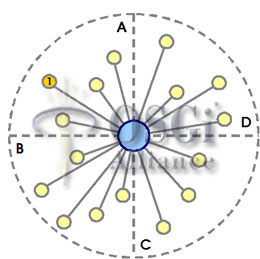Revision control concepts – Revision Control System (RCS), Concurrent Versions System (CVS) and Subversion
 Revision control (also known as version control (system) (VCS), source control or (source) code management (SCM)) is the management of multiple revisions of the same unit of information. It is most commonly used in engineering and software development to manage ongoing development of digital documents like application source code, art resources such as blueprints or electronic models, and other projects that may be worked on by a team of people. Changes to these documents are usually identified by incrementing an associated number or letter code, termed the “revision number”, “revision level”, or simply “revision” and associated historically with the person making the change. A simple form of revision control, for example, has the initial issue of a drawing assigned the revision number “1”. When the first change is made, the revision number is incremented to “2” and so on.
Revision control (also known as version control (system) (VCS), source control or (source) code management (SCM)) is the management of multiple revisions of the same unit of information. It is most commonly used in engineering and software development to manage ongoing development of digital documents like application source code, art resources such as blueprints or electronic models, and other projects that may be worked on by a team of people. Changes to these documents are usually identified by incrementing an associated number or letter code, termed the “revision number”, “revision level”, or simply “revision” and associated historically with the person making the change. A simple form of revision control, for example, has the initial issue of a drawing assigned the revision number “1”. When the first change is made, the revision number is incremented to “2” and so on.
Enterprise resource planning (ERP) – Concepts, Methods and Frameworks
 Enterprise resource planning (ERP) is an enterprise-wide information system designed to coordinate all the resources, information, and activities needed to complete business processes such as order fulfillment or billing.
Enterprise resource planning (ERP) is an enterprise-wide information system designed to coordinate all the resources, information, and activities needed to complete business processes such as order fulfillment or billing.
An ERP system supports most of the business system that maintains in a single database the data needed for a variety of business functions such as Manufacturing, Supply Chain Management, Financials, Projects, Human Resources and Customer Relationship Management.
An ERP system is based on a common database and a modular software design. The common database can allow every department of a business to store and retrieve information in real-time. The information should be reliable, accessible, and easily shared. The modular software design should mean a business can select the modules they need, mix and match modules from different vendors, and add new modules of their own to improve business performance.
Se-Radio.net: Bran Selic on UML 2
 The Unified Modeling Language (UML) is a graphical language for visualizing, specifying and constructing the artifacts of a software-intensive system. The Unified Modeling Language offers a standard way to write a system’s blueprints, including conceptual things such as business processes and system functions as well as concrete things such as programming language statements, database schemas, and reusable software components. UML combines the best practice from data modeling concepts such as entity relationship diagrams, business modeling (work flow), object modeling and component modeling. It can be used with all processes, throughout the software development life cycle, and across different implementation technologies.
The Unified Modeling Language (UML) is a graphical language for visualizing, specifying and constructing the artifacts of a software-intensive system. The Unified Modeling Language offers a standard way to write a system’s blueprints, including conceptual things such as business processes and system functions as well as concrete things such as programming language statements, database schemas, and reusable software components. UML combines the best practice from data modeling concepts such as entity relationship diagrams, business modeling (work flow), object modeling and component modeling. It can be used with all processes, throughout the software development life cycle, and across different implementation technologies.
Differences and Similarities between Design Patterns and Architectural Styles
 [Def.] A pattern, from the French patron, is a theme of recurring events or objects, sometimes referred to as elements of a set. These elements repeat in a predictable manner. It can be a template or model which can be used to generate things or parts of a thing, especially if the things that are created have enough in common for the underlying pattern to be inferred, in which case the things are said to exhibit the unique pattern.
[Def.] A pattern, from the French patron, is a theme of recurring events or objects, sometimes referred to as elements of a set. These elements repeat in a predictable manner. It can be a template or model which can be used to generate things or parts of a thing, especially if the things that are created have enough in common for the underlying pattern to be inferred, in which case the things are said to exhibit the unique pattern.
[Def.] Design, usually considered in the context of applied arts, engineering, architecture, and other creative endeavors, is used both as a noun and a verb. As a verb, “to design” refers to the process of originating and developing a plan for a product, structure, system, or component.
In software engineering, a design pattern is a general reusable solution to a commonly occurring problem in software design. A design pattern is not a finished design that can be transformed directly into code. It is a description or template for how to solve a problem that can be used in many different situations. Object-oriented design patterns typically show relationships and interactions between classes or objects, without specifying the final application classes or objects that are involved. Algorithms are not thought of as design patterns, since they solve computational problems rather than design problems.
Not all software patterns are design patterns. Design patterns deal specifically with problems at the level of software design. Other kinds of patterns, such as architectural patterns, describe problems and solutions that have alternative scopes.
Turing Test on six machine: Loebner Prize in Artificial Intelligence
 The Turing Test was introduced by Alan M. Turing (1912-1954) as “the imitation game” in his 1950 article (now available online) Computing Machinery and Intelligence (Mind, Vol. 59, No. 236, pp. 433-460) which he so boldly began by the following sentence:
The Turing Test was introduced by Alan M. Turing (1912-1954) as “the imitation game” in his 1950 article (now available online) Computing Machinery and Intelligence (Mind, Vol. 59, No. 236, pp. 433-460) which he so boldly began by the following sentence:
I propose to consider the question “Can machines think?” This should begin with definitions of the meaning of the terms “machine” and “think.”
Turing Test is meant to determine if a computer program has intelligence. Quoting Turing, the original imitation game can be described as follows:
New episode from SE-Radio.net: Basic Introduction to AOP (Aspect Oriented Programming)
 I want to post the SE-Radio.net Episode 106 about AOP programming and two nice presentations from slideshare.net.
I want to post the SE-Radio.net Episode 106 about AOP programming and two nice presentations from slideshare.net.
AOP importance is increasing in the past few years, Spring are using it in a widely manner and also OSGi have announced few month ago your Aspect bundle for weaving at run-time (Equinox Aspect). So AOP have a grait impact on present programming and I think that it will have also with future programming.
Continue Reading 18 September, 2008 at 11:58 Leave a comment
Mashup (hybrid web application): new generation of Web-based applications
 Mashups are new and exciting aspects of Web 2.0. As is often the case with new technologies or approaches the industry often gets caught up in promoting the value proposition of what’s emerging. The hype often muddies the water between the value of what can be created with the new technology and the value of what exists today. With mashups, it’s often unclear to IT professionals how their existing Web applications might be different from the proposed innovative approach to mashing-up data with a browser.
Mashups are new and exciting aspects of Web 2.0. As is often the case with new technologies or approaches the industry often gets caught up in promoting the value proposition of what’s emerging. The hype often muddies the water between the value of what can be created with the new technology and the value of what exists today. With mashups, it’s often unclear to IT professionals how their existing Web applications might be different from the proposed innovative approach to mashing-up data with a browser.
One of the first questions that customers often ask is “What’s the difference between a mashup and the Web applications that we currently use in our enterprise today?” The difference has little to do with technology or the integration of systems. Instead, it reflects the ease with which the application can be created by users, how the application is intended to be used, and the lack of nonfunctional requirements (for example, reliability, availability, and performance) that need to be addressed after the mashup or Web application is deployed.
JavaFX: Tutorials and Demos
 JavaFX is a family of products for creating Rich Internet Applications (RIAs) with immersive media and content. The JavaFX products include a runtime and tools suite that web scripters, designers and developers can use to quickly build and deliver expressive rich interactive applications for desktop, mobile, TV and other platforms. Currently JavaFX consists of JavaFX Script and JavaFX Mobile.
JavaFX is a family of products for creating Rich Internet Applications (RIAs) with immersive media and content. The JavaFX products include a runtime and tools suite that web scripters, designers and developers can use to quickly build and deliver expressive rich interactive applications for desktop, mobile, TV and other platforms. Currently JavaFX consists of JavaFX Script and JavaFX Mobile.
The Internet’s Biggest Security Hole: exploiting the internet routing protocol BGP (Border Gateway Protocol)
 […] Two security researchers have demonstrated a new technique to stealthily intercept internet traffic on a scale previously presumed to be unavailable to anyone outside of intelligence agencies like the National Security Agency.
[…] Two security researchers have demonstrated a new technique to stealthily intercept internet traffic on a scale previously presumed to be unavailable to anyone outside of intelligence agencies like the National Security Agency.
The tactic exploits the internet routing protocol BGP (Border Gateway Protocol) to let an attacker surreptitiously monitor unencrypted internet traffic anywhere in the world, and even modify it before it reaches its destination.
R-OSGi and Distributed OSGi: differences and similarities
ECF Eclipse Communication Framework is a framework for supporting the development of distributed Eclipse-based tools and applications. It can be used to create other plugins, tools, or full Eclipse RCP applications that require asynchronous point-to-point or publish-and-subscribe messaging.








Recent Comments